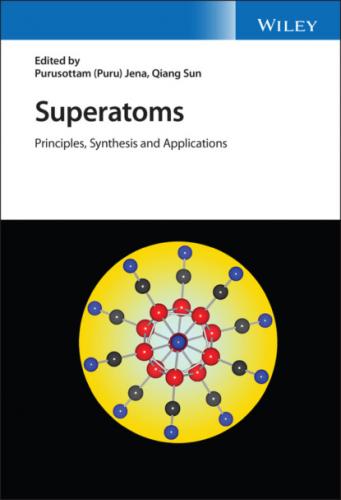2.3 Stabilizing Negative Ions Using Multiple Electron‐Counting Rules
In the preceding section, we discussed how stable clusters can be designed by satisfying any one of the electron‐counting rules such as the jellium rule for free‐electron systems; the octet rule for low atomic number elements; the 18‐ and 32‐electron rule for clusters containing transition and rare earth metal atoms, respectively; the aromatic rule for organic molecules; and the Wade‐Mingos rule for boron‐based clusters and Zintl ions. These rules can also be used to design reactive clusters by requiring that they either contain less or more electrons than needed for shell closure. In particular, we discussed the design of superalkalis and superhalogens. Over the past five years, Jena and his group [94, 95] have been studying systematically how unusually stable or reactive clusters can be designed by using multiple electron‐counting rules simultaneously and how such clusters can be used to promote reactions and properties otherwise unthinkable. Consider, for example, multiply charged negative ions. We know that most atoms in the periodic table have positive electron affinity, i.e., they gain energy as an extra electron is attached. However, an atom with two extra electrons will spontaneously eject the second electron due to Coulomb repulsion. On the other hand, a cluster or a molecule in the dianionic form can be stable if they satisfy one of two criteria; either they are large enough so that the electron–electron repulsion is smaller than the binding energy or addition of electrons satisfies electronic shell closure. As we have pointed out before, B12H12 2− is a classic example of a stable dianion in the gas phase. Its stability stems from the fact that the second electron satisfies the Wade‐Mingos rule. A lot of work has been done to understand the stability of multiply charged ions. While there are examples of stable dianions, clusters carrying three or more extra electrons are rare. In the following we discuss how the use of multiple electron‐counting rules can be used to design clusters with large electron affinities as well as clusters capable of carrying three or more extra electrons.
2.3.1 Monoanions
In previous sections we have discussed the design of stable monoanions by using a single electron‐counting rule. Here, we discuss how the stability of monoanions can be further enhanced by using multiple electron‐counting rules. Recall that C6H6 has a negative electron affinity, which can be systematically increased by replacing H by F (see Table 2.2). Driver and Jena [73] have systematically replaced H atoms with a BO2 moiety. Note that BO2 − is isoelectronic with CO2 and is a very stable molecule. Indeed, it is a superhalogen with an electron affinity of 4.46 ± 0.03 eV [96]. In Figure 2.25 we show the equilibrium geometries of neutral and anionic C6H6 − x (BO2) x , x = 1–6. Note that in most situations BO2 molecules dimerize and bind to the carbon atoms. From Table 2.2 we see that the electron affinity increases systemically as H is replaced by F and BO2 and reaches a value of 1.80 eV in C6(BO2)6. Note that C6(BO2)6 satisfies both the aromatic rule and the octet rule. The electron affinity can be further increased by replacing one of the C atoms with B. The equilibrium geometries of neutral and anionic BC5H6 − x (BO2) x , x = 1–6 are shown in Figure 2.26, and the corresponding electron affinities are given in Table 2.2. Thus, a benzene molecule can be made into a superhalogen by suitable modification, and the electron affinity of BC5H(BO2)5 surpasses that of Cl. In general, the electron affinity of a cluster can be increased by choosing the composition of a cluster that satisfies multiple electron‐counting rules. This can be seen from several recent publications [97, 98].
Figure 2.25 Ground state geometries of neutral and anionic C6H6 − x (BO2) x . The gray, white, pink, and red spheres correspond to carbon, hydrogen, boron, and oxygen, respectively.
Source: Driver [73].
Figure 2.26 Ground state geometries of neutral and anionic C5BH6 − x (BO2) x . The gray, white, pink, and red spheres correspond to carbon, hydrogen, boron, and oxygen atoms, respectively.
Another example where the use of both octet rule and aromaticity rule can simultaneously give rise to stable monoanions is BC5H6 − x (CN) x , x = 1–6. Here, the H atoms in C6H6 are sequentially replaced by superhalogen CN. The electron affinities of these clusters calculated using density functional theory and B3LYP hybrid exchange‐correlation potential with 6‐31 + G* basis set implemented in the Gaussian 16 code are given in Figure 2.27. Note that electron affinity of BC5(CN)6 is close to 6 eV, making it a hyperhaolgen. It is interesting to compare the electron affinities of these clusters with isoelectronic C5H5 − x (CN) x , x = 1–5. The results are compared with the electron affinities BC5H6 − x (CN) x in Figure 2.27. As the number of CN ligands increases, the electron affinities of both these two classes of clusters become identical, indicating that the ligands as well as total number of “valence” electrons play a role in stabilizing the monoanions.
Figure 2.27 Electron affinities of BC5H6 − x (CN) x , x = 1–6 and their isoelectronic C5H5 − x (CN) x , x = 1–5.
Unusually stable clusters can also be created by satisfying three electron‐counting rules, simultaneously. Consider, for example, Mn[BC5(CN)6]2 − that satisfies the aromaticity rule, the octet rule, and the 18‐electron rule, simultaneously. The geometry of neutral and anionic Mn[BC5(CN)6]2 − cluster computed by Giri et al. [94] is shown in Figure 2.28. Here, Mn is sandwiched between two BC5(CN)6 molecules. Another consequence of the electron shell closure is that the magnetic moment of the Mn atom is quenched. The octet shell closure enables CN to have an electron affinity of 3.86 eV. The electron affinity of BC5(CN)6, which satisfies both the octet rule and aromaticity rule is 5.87 eV. Mn[BC5(CN)6]2, satisfying three electron‐counting
